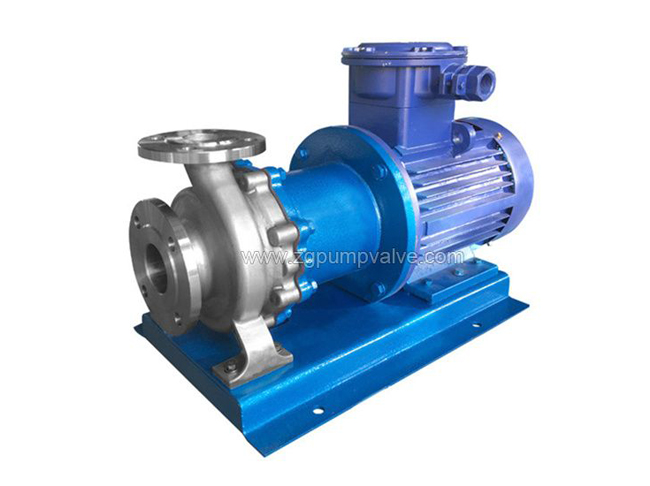Learn - Nov. 17, 2020
Magnetic transmission is the use of magnets to attract ferromagnetic materials and the magnetic force between magnets or magnetic fields. Non-ferromagnetic materials do not affect or rarely affect the magnitude of the magnetic force, so it can pass through non-magnetic conductors (isolation sleeves) without contact ) Perform power transmission.
The magnetic drive can be divided into the synchronous or asynchronous design. Most magnetic drive pumps adopt the asynchronous design. The motor is connected to the outer magnetic cylinder through an external coupling, and the impeller is connected to the inner magnetic cylinder. A fully-sealed isolation sleeve is set between the outer magnetic cylinder and the inner magnetic cylinder to completely separate the inner and outer magnetic cylinders so that the inner magnetic cylinder is in the medium, and the rotor shaft of the motor directly drives the impeller synchronization through the attraction of the magnetic poles between the magnetic cylinders. Rotate.
Asynchronous design magnetic transmission also called torque ring magnetic transmission, uses a cage-shaped torque ring to replace the inner magnetic cylinder. The torque ring is similar to the rotor of an asynchronous motor. The induced electromotive force and the magnetic field are generated in the rotating magnetic field generated by the outer magnetic cylinder. Induces a magnetic field, which rotates at a slightly lower speed. Since there is no permanent magnet in the inner magnetic cylinder, its use temperature is higher than that of the synchronous drive magnetic drive.
The magnetic drive is completed by a magnetic coupling. The magnetic coupler mainly includes parts such as the inner magnetic cylinder, outer magnetic cylinder, and isolation sleeve, which is the core component of the magnetic pump. The structure of the magnetic coupling, the design of the magnetic circuit, and the materials of its parts are related to the reliability, magnetic transmission efficiency, and life of the magnetic pump. The magnetic coupling is suitable for outdoor startup and continuous operation under the specified environmental conditions, and there should be no decoupling and demagnetization.
The inner magnetic cylinder should be firmly fixed on the guide ring with adhesive, and the inner magnetic cylinder is separated from the medium with a sheath. The minimum thickness of the sheath should be 0.4mm, and the material should be non-magnetic and suitable for the conveyed medium.
The outer magnetic cylinder should also be firmly fixed on the outer magnetic cylinder guide ring with adhesive. In order to prevent atmospheric corrosion, damage to the isolation sleeve by the outer magnetic cylinder and possible collision sparks under accident conditions, and to prevent damage to the outer magnetic cylinder during assembly, the inner surface of the outer magnetic cylinder should preferably be covered with a cover. The sleeve should be a material that does not produce sparks.

Synchronous magnetic couplers should use rare earth magnetic materials such as samarium cobalt and neodymium iron boron; torque ring actuators can use rare earth magnetic materials such as samarium cobalt and neodymium iron boron. To adapt to high-temperature conditions, aluminum nickel cobalt magnetic materials can also be used. The magnetic energy product of neodymium iron boron is higher than that of samarium cobalt. The disadvantage is that the operating temperature is only 120°C and the magnetic stability is relatively poor. Samarium Cobalt has high magnetic transmission efficiency and magnetic energy product and has a strong anti-demagnetization ability. There are usually two types of samarium cobalt used in magnetic pumps, Ming cobalt 1.5 grade Sm1Co5 and 2.17 grade Sm2Co17. Samarium cobalt 1.5 grade contains 35% samarium, 65% cobalt, the highest operating temperature is 250℃, and the Curie temperature is 523℃; Ming cobalt 2.17 grade contains 25% of shirts, 50% of cobalt, 25% of titanium and iron, and its highest operating temperature is up to 350℃, Curie temperature 750℃.
The isolation sleeve is also called an isolation cover or a sealing sleeve. It is located between the inner and outer magnetic cylinders and completely separates the inner and outer magnetic cylinders, and the medium is enclosed in the isolation sleeve. The thickness of the isolating sleeve is related to the working pressure and operating temperature. If it is too thick, the gap size between the inner and outer cylinders will be increased, the magnetic transmission torque will be reduced, and the eddy current loss in the isolating sleeve will be increased, thereby affecting the efficiency of the magnetic transmission; Affect strength and stiffness.
There are two types of isolation sleeves: metal and non-metal. The metal isolation sleeve has eddy current loss, and the non-metal isolation sleeve has no eddy current loss. The metal isolation sleeve should be made of materials with high resistivities, such as Hastelloy, titanium alloy, etc., or austenitic stainless steel, whose thickness is generally 1.0~1.2mm. For low-power magnetic pumps and when the operating temperature is low, non-metallic materials, such as plastic or ceramics, can also be considered for the isolation sleeve.
Magnetic pumps generally use silicon carbide ceramic bearings. In order to prevent silicon carbide from containing free silicon, thereby reducing its corrosion resistance, it is generally required to use pressureless sintered α silicon carbide. Silicon carbide sliding bearings have a high load-carrying capacity, strong erosion resistance, chemical corrosion resistance, abrasion resistance, and good heat resistance. The service temperature can reach above 500℃. The service life of silicon carbide sliding bearings can generally reach more than 3 years.
Silicon carbide bearings are usually mounted on metal parts. Since the thermal expansion coefficient of silicon carbide is much smaller than that of general metal materials, special inlay structures (such as metal corrugated pads) or special metal materials (such as titanium alloys) should be used when transporting high temperature or low-temperature media.
Graphite has good self-lubricating properties, can withstand short-term dry operation, and the use temperature can reach 450°C. The disadvantage is poor wear resistance. The service life of graphite sliding bearings can generally reach more than 1 year.
The above information is provided by the magnetic pump supplier.